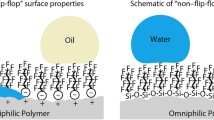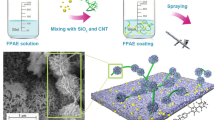Abstract
A simple and conventional PECVD method was adopted to synthesize scratch-resistant hydrophobic and oleophobic films, by varying the process condition. The film was designed to be 3 layered. The first SiOx layer was coated on the substrate using OMCTS and O2, followed by O2 plasma treatment; hydrocarbon-based hydrophobic film was synthesized using HMDS as a second layer; and finally, CFx-based film was coated using C2F6. The first and second layers were synthesized using RF power of 13.56 MHz, while MF power of 40 kHz was used for the CFx layer for ion-assisted deposition. The water contact angle was measured to be 110°–115°, and the oil contact angle was 84° for the best obtained sample. The pencil hardness was measured to be 7H for anti-scratch property. XPS was adopted to analyze the chemical structure and showed that highly cross-linked dense structured film was synthesized.






Similar content being viewed by others
References
Genzer J, Efimenko K (2006) Recent developments in superhydrophobic surfaces and their relevance to marine fouling: a review. Biofouling 22(5):339–360
Arkles B, Pan Y, Kim YM (2009) The role of polarity on the substitution of silanes employed in surface modification. In: Mittal K (ed) Silanes and other coupling agents, vol 5. VSP/Brill, Leiden, pp 51–64
Wang X, Harris HR, Boudin K, Temkin H, Gangopadhyay S (2000) Structural properties of fluorinated amorphous carbon films. J Appl Phys 87:621–623
Agraharam S, Hess DH, Kohl PA, Bdstrup Allen SA (2000) Thermal stability of fluorocarbon films deposited from pentafluoroethane/argon plasmas. J Electrochem Soc 147:2665–2670
Srividya C, Babu SV, Visser SA (1998) Surface and corrosion characteristics of a-C:H/Fluorocarbon films. J Adhesion 67:81–95
Żenkiewicz M (2007) Methods for the calculation of surface free energy of solids. J Achieve Mater Manuf Eng 24:137–145
Nishino T, Meguro M, Nakamae K, Matsushita M, Ueda Y (1999) The lowest surface free energy based on –CF3 alignment. Langmuir 15:4321–4323
Bendavid A, Martin PJ, Randeniya L, Amin MS, Rohanizadeh R (2010) The properties of fluorine containing diamond-like carbon films prepared by pulsed DC plasma-activated chemical vapor deposition. Diam Relat. Mater. 19:1466–1471
Chen R, Gorelik V, Silverstein MS (1995) Plasma polymerization of hexafluoropropylene film deposition and structure. J Appl Polym Sci 56:615–623
Lee J, Kim KJ, Lee Y (2011) Characterization of fluorocarbon thin films deposited by ICP and PP. J Surf Anal 17:269–273
Kim Y, Kim KJ, Lee Y (2009) Surface analysis of fluorine-containing thin films fabricated by various plasma polymerization methods. Surf Coat Technol 203:3129–3135
Labelle CB, Opila R, Kornblit A (2005) Plasma deposition of fluorocarbon thin films from c-C4F8 using pulsed and continuous rf excitation. J Vac Sci Technol A 23(1):190–196
Valentini L, Braca E, Kenny JM, Lozzi L, Santucci S (2001) Influence of plasma source frequency on composition and density of fluorinated amorphous carbon thin films. Mater Lett 51:514–518
Nogueira S, da silva MLP, Tan IH, Furlan R (2006) Production of highly hydrophobic films using low frequency and high density plasma. Revista Brasileira de Aplicações de Vácuo 25:45–53
Ma Y, Yang H (1998) Structural and electronic properties of low dielectric constant fluorinated amorphous carbon films. Appl Phys Lett 72:3353–3355
d’Agostino R, Cramarossa F, Illuzzi F (1987) Mechanisms of deposition and etching of thin films of plasma-polymerized fluorinated monomers in radiofrequency discharges fed with C2F6-H2 and C2F6-O2 mixtures. J Appl Phys 61:2754–2762
O’Keefe MJ, Rigsbee JM (1994) Influence of Substrate Material and Ion Bombardment on Plasma-Deposited Fluorocarbon Thin Films. J Appl Polym Sci 53:1631–1638
Von Keudell A, Jacob W (2004) Review elementary processes in plasma-surface interaction: H-atom and ion-induced chemisorptions of methyl on hydrocarbon film surfaces. Prog Surf Sci 76:21–54
Von Keudell A, Meier M, Hopf C (2002) Growth mechanism of amorphous hydrogenated carbon. Diamond Relat Mater 11:969–975
Huang KP, Lin P, Shih HC (2004) Structures and properties of fluorinated amorphous carbon films. J Appl Phys 96:354–360
Nanse G, Papirer E, Fioux P, Moguet F, Atressaud A (1997) Fluorination of Carbon Blacks: An X-Ray Photoelectron Spectroscopy Study: I. A Literature Review of XPS Studies of Fluorinated Carbons. XPS Investigation of some reference Compounds. Carbon 35:175–194
Tamada K, Ishida T, Knoll W, Fukushima H (2001) Molecular packing of semifluorinated alkanethiol self-assembled monolayers on gold: influence of alkyl spacer length. Langmuir 17:1913–1921
Yun SM, Kim JW, Jung MJ, Nho YC, Kang PH, Lee YS (2007) An XPS study of oxyfluorinated multiwalled carbon nano tubes. Carbon Lett 8:292–298
Köller K, Horne ED, Coburn JW (1985) Frequency dependence of ion bombardment of grounded surfaces in rf argon glow discharges in a planar system. J Appl Phys 58:3350–3355
Wijesundara MBJ, Hanley L, Ni B, Sinnott SB (2000) Effects of unique ion chemistry on thin-film growth by plasma-surface interactions. PNAS 97:23–27
Acknowledgements
The authors are grateful for the financial support provide by the National Research Foundation of Korea (NRF), through the Institute for Plasma-Nano Materials, at Sungkyunkwan University.
Author information
Authors and Affiliations
Corresponding author
Rights and permissions
About this article
Cite this article
Choi, Y.S., Lee, J.S. & Han, J.G. Scratch-resistant hydrophobic and oleophobic coatings prepared by simple PECVD method. J Mater Sci 49, 4790–4795 (2014). https://doi.org/10.1007/s10853-014-8178-3
Received:
Accepted:
Published:
Issue Date:
DOI: https://doi.org/10.1007/s10853-014-8178-3




